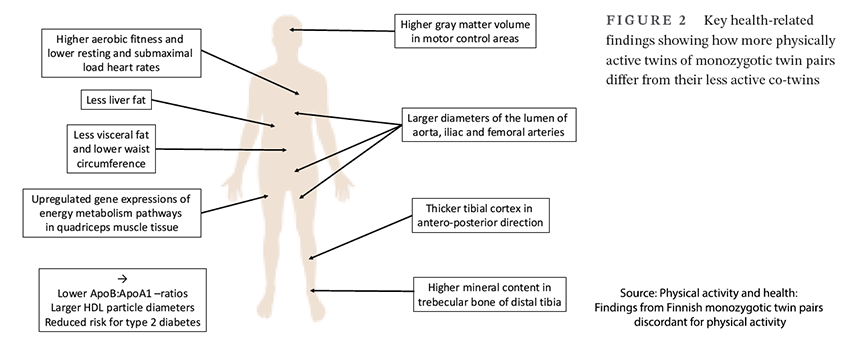The short answer to this question is: If we consider monozygotic (identical) twins, then it's a firm somewhat. A new study looks at the impact of differing leisure time physical activity and twins' health.
Most non-communicable diseases have multifactorial causes, making it difficult to tease out the impact of just one factor, in this case, physical activity. But if we begin with twins, where the genetics are identical, we may not determine causality, but we can more accurately identify the role of physical activity and our health.
The dataset comes from two Finnish registries of twins, an older group in the range of 50 to 74 and a younger group in the age range of 32 to 36. What was more difficult was to identify twins with discordant patterns of exercise. But they found 17 pairs, so the sample size is low and numerical results, despite appearing “firm,” are a bit fuzzy. The difference in daily physical activity was 4.1 MET-hours between the active and “less-active” twins.
METs are a measure of our metabolic activity. One MET is equivalent to burning one calorie a minute. Men typically burn 70 METs an hour, and women 60 METs, while sitting quietly. Moderate exercise involves 4 to 6 METS, consistent with our twins' differences. Vigorous exercise increases METS to 6 or more. For those who just have to know, you can find a listing of activities and METS here.
- The active twins' body weight was 1.8 kg lower, but this difference was not as significant as the difference in body fat composition. More specifically, the active twin had a lower percentage of fat, and visceral fat, including within the liver. Visceral fat is hidden within our body cavities and constitutes about 10% of our total fat. While most studies have associated NCDs with body fat, visceral fat is particularly concerning because it generates inflammatory proteins and signals. The buildup of fats within the liver occurs over a spectrum causing enhanced inflammation and scarring of the liver as it becomes more pathogenic and disease-causing. Here’s the take-home – BMI is not the best measure of weight’s impact on our metabolism or health; the composition of that weight, the amount of fat, may be more important.
- The exercise by the more active twin resulted in larger diameter blood vessels feeding the legs by roughly 13%. That makes sense because you need a larger conduit to provide the extra blood flow associated with exercise. Moreover, the genes involved in muscle energetics were up-regulated. There were changes in the internal dimensions of the tibia, the shin bone of our lower legs which reflected the changing loads on the bone from exercise, but the overall dimensions of the bone were unchanged. Take-home – exercise alters our anatomy and metabolism to compensate for the increasing energy expenditures and physical stress.
- Exercise did not affect the carotid artery, which supplies blood to our brain. This is not surprising because the circulatory system is hardwired to feed the brain as much blood as it wants or needs. In addition to the carotid arteries, there are two vertebral arteries in the back of our neck that supply the brain, and a traffic circle of sorts, the circle of Willis, that connects the blood flow from the carotids and the vertebrals to provide even distribution of blood throughout the brain. Total white and gray matter and overall intracranial volumes were unchanged by exercise. But the researchers noted differences regionally, promoting increased volume in “motor control areas.” Take-home – while exercising is a smart thing to do, it will not necessarily make you smarter.
Exercise does make a difference as our body adjusts to increased activity. Those changes have been associated with a diminished risk of developing NCDs. But just before we can conclude that nurture is the driver, the researchers make this salient point.
“…It is uncommon that co-twins of a MZ twin pair have persistently different activity levels, and it was therefore difficult to find large number of MZ twin pairs significantly discordant for long-term physical activity. This limitation itself speaks for a genetic and other familial basis for lifetime activity patterns."
That last line is intriguing. Could our desire to exercise be, in part, genetic, or is it that shared environment those twins grew up in that nudged them towards more activity?
We may never disentangle nature from nurture; it may be a fool’s errand. But the study does suggest that remaining active, participating in some form of daily exercise is good for your health. But you knew that already, didn’t you?
Source: Physical activity and health: Findings from Finnish monozygotic twin pairs discordant for physical activity Scandinavian Journal of Medicine and Science in Sports DOI: 10.1111/sms.14205


